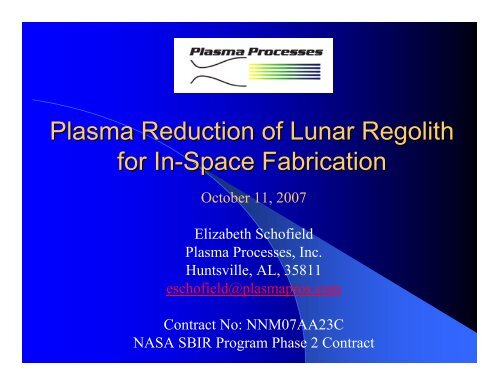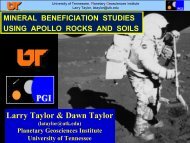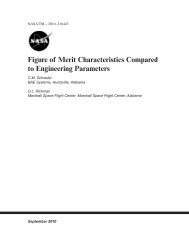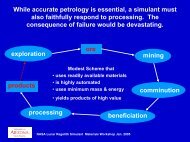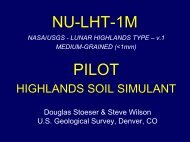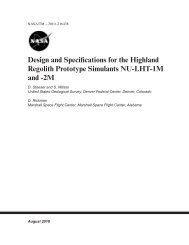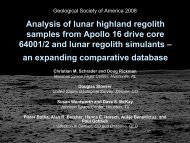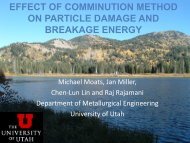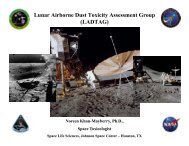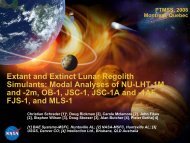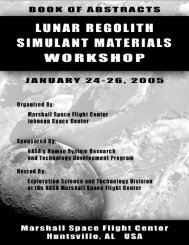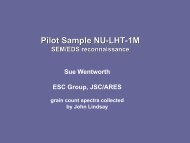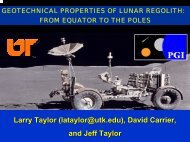Plasma Reduction of Lunar Regolith for In-Space ... - ISRU - Nasa
Plasma Reduction of Lunar Regolith for In-Space ... - ISRU - Nasa
Plasma Reduction of Lunar Regolith for In-Space ... - ISRU - Nasa
Create successful ePaper yourself
Turn your PDF publications into a flip-book with our unique Google optimized e-Paper software.
<strong>Plasma</strong> <strong>Reduction</strong> <strong>of</strong> <strong>Lunar</strong> <strong>Regolith</strong><strong>for</strong> <strong>In</strong>-<strong>Space</strong> FabricationOctober 11, 2007Elizabeth Sch<strong>of</strong>ield<strong>Plasma</strong> Processes, <strong>In</strong>c.Huntsville, AL, 35811esch<strong>of</strong>ield@plasmapros.comContract No: NNM07AA23CNASA SBIR Program Phase 2 Contract
Overview <strong>of</strong> <strong>Plasma</strong> Processes, <strong>In</strong>c.<strong>Plasma</strong> Processes, <strong>In</strong>c is aISO 9001:2000-certifiedsmall business specializingin the development andmanufacture <strong>of</strong> high andultra-high temperaturematerials, coatings, netshapestructures, and powderprocessing services.<strong>Plasma</strong> Processes, <strong>In</strong>c 10-11-07
VPS Manufacturinga) b)c)a) W non-eroding throat fabricated at PPI with a carbon diffusion barrier on the ODb) W throat during VPS fabricationc) Same throat after W depositionTechnical Pr<strong>of</strong>ile:1) Extremely high deposition rates; up to 15 lbs per hour2) Thicknesses from 0.001 inches to 3.0+ inches3) Largest VPS chamber can accommodate part 3.5’ diameter x 6’ high4) 2 x VPS chambers online; 3 rd in progress5) Manufacture in inert atmosphere with choice <strong>of</strong> inert gases<strong>Plasma</strong> Processes, <strong>In</strong>c 10-11-07
<strong>Plasma</strong> <strong>Reduction</strong> OptimizationPPI Patented bellcontoured parallel flownozzles eliminatedisruptive shock wavesand expansion fans inplasma plume,providing ideallyexpanded plasma gasand collimated flow <strong>for</strong>better particleentrainment and spraycharacteristics.<strong>Plasma</strong> Processes, <strong>In</strong>c 10-11-07
Powder Alloying andSpheroidization SM (PAS SMProcessSM )• Powder feedstock is fed into a plasma.• Reaction between the plasma and feedstock resultsin melting/evaporation <strong>of</strong> the feedstock material.• Droplets pass out <strong>of</strong> the plasma, rapidly solidifyand are collected.• Vacuum or inert atmosphere <strong>for</strong> oxygen sensitivematerials, or ambient conditions.• Auxiliary cooling gases enhance powder cooling.• Argon plasma gas and hydrogen secondary gastypically used.<strong>Plasma</strong> Processes, <strong>In</strong>c 10-11-07
<strong>Plasma</strong> <strong>Reduction</strong>Experimental Setup<strong>Plasma</strong> Processes, <strong>In</strong>c 10-11-07
Significance <strong>of</strong> this Ef<strong>for</strong>t• Raw materials (e.g., metals and O 2 ) are needed <strong>for</strong>in-space fabrication, life support, and fuel use.• An innovative plasma reduction technique has beenused to produce Si, Fe, & Mg metals and gases fromJSC-1 lunar regolith simulant during Phase 1.• During Phase 2, plasma reduction techniques arebeing optimized to produce pure O 2 and additionalmetals such as Al, Ti and Ca from regolith simulant.• The development <strong>of</strong> these technologies are vital <strong>for</strong>long-term <strong>Lunar</strong> and Martian exploration.<strong>Plasma</strong> Processes, <strong>In</strong>c 10-11-07
NASA and Non-NASANASAApplications <strong>of</strong> Phase 2 Technology• O 2 (H 2 O) <strong>for</strong> life-support, habitat and propulsion use• Mature lunar simulant <strong>for</strong> dust, abrasion, mining &excavation research• Metallic feedstock <strong>for</strong> in-space fabrication and rapidprototyping: Si - solar cells; Al, Ti, Fe - structural useOther Applications:Powder metallurgy products, protective coatings,catalysts, composite additives, sintering aids,micr<strong>of</strong>iltration membranes, rocket fuel additives,rocket motors, electronics, fuel cell technologies<strong>Plasma</strong> Processes, <strong>In</strong>c 10-11-07
JSC-1 1 <strong>Lunar</strong> <strong>Regolith</strong> SimulantXRD analysis <strong>of</strong> As-received JSC-1 powder containing acomplicated mixture <strong>of</strong> many minerals. Positively identified arealbite (NaAlSi3O8) and anorthite (Al2O3◦CaO◦2SiO2). Smallamounts <strong>of</strong> magnetite (Fe3O4), akermanite(2CaO◦MgO◦2SiO2), oligoclase [(Na,Ca)Al(Al,Si)Si2O8], andlabradorite (Na2O◦2CaO◦3Al2O3◦8SiO2) might be present.<strong>Plasma</strong> Processes, <strong>In</strong>c 10-11-07
JSC-1 1 <strong>Lunar</strong> <strong>Regolith</strong> SimulantAs-Received <strong>Lunar</strong> <strong>Regolith</strong> Simulant (JSC-1)300x 1000x 5000xS06-215 – after plasma processing100x 3000x 3000xAs-received and plasma processed (S06-215) lunar regolith simulant (JSC-1) at severalmagnifications showing spherical and agglutinate morphology.<strong>Plasma</strong> Processes, <strong>In</strong>c 10-11-07
JSC-1A Simulant (As-Received)vs. JSC-1<strong>Plasma</strong> Processes, <strong>In</strong>c 10-11-07JSC-1
<strong>Lunar</strong> <strong>Regolith</strong> Simulant(a) XRD pattern <strong>of</strong> plasma processed JSC-1 simulant showing predominant presence<strong>of</strong> amorphous or glassy phase and (b) after background reduction shows the presence<strong>of</strong> graphite (C), Fe (bcc), Mg, and hexagonal quartz (SiO 2 ), and potentially additionalreduced metallic species in a non-crystalline state.<strong>Plasma</strong> Processes, <strong>In</strong>c 10-11-07
Agglutinate & Volcanic GlassAnalogue ParticlesAgglutinate ((a) A2)and (b)Spherical Particle((a) A1)(a) (b)Spot number Mg Al Si Ca Fe Ti O (balance) Total(b) 1 Matrix 3.330 9.880 21.900 8.460 6.790 1.080 48.380 100(b) 2 Bright spots 3.090 0.960 21.480 0.530 68.740 0.700 4.500 1001 0.001 10.380 34.110 0.015 0.072 0.004 55.410 1002 2.076 4.010 16.330 6.630 5.110 0.738 65.110 1003 3.450 4.630 16.740 6.930 7.140 1.349 59.760 1004 3.810 7.660 22.820 8.340 8.930 1.284 47.150 1005 0.787 4.810 12.250 3.790 10.890 0.632 66.850 100EDS analysis <strong>of</strong> S06-215 showing elemental iron on agglutinate surface (a – A2) anddispersed within agglutinate (b – 2). Shown in view (a) (3000x) are spherical particlessimilar to lunar volcanic glass (A1) and agglutinate similar to lunar agglutinates (A2).View (b) is a cross sectional view <strong>of</strong> a particle similar to A2 showing elemental iron onthe surface <strong>of</strong> the agglutinate and dispersed within it (arrow 2) and the matrix material(arrow 1).<strong>Plasma</strong> Processes, <strong>In</strong>c 10-11-07
Assessment <strong>of</strong> Additives toImprove <strong>Lunar</strong> <strong>Regolith</strong> Simulant• Simulant particles were produced during Phase 1 withmorphology very similar to lunar agglutinates and volcanicglasses• Micron sized Fe observed on particle surfaces and interiors –will determine if nano-size Fe is also present during Phase 2• Restoration <strong>of</strong> angular/faceted surfaces• Creation <strong>of</strong> different size agglutinates• Glassy phase / agglutinate separation• Define processing parameters needed to produce either type <strong>of</strong>particle during Phase 2• Combine with JSC-1A Standard to produce mature soil simulant.• Characterization <strong>of</strong> mature simulant (composition, morphology,hardness, grain interlocking <strong>of</strong> bulk soil, cohesion, ect.)• <strong>Plasma</strong> processing is rapid, low cost, and high-volume.<strong>Plasma</strong> Processes, <strong>In</strong>c 10-11-07
As-Received Martian Soil Simulant (JSC MARS-1)JSC Mars-1Martian<strong>Regolith</strong>SimulantS06-219S06-220300x 1000x 5000x300x 1000x 3000x300x 1000x 5000xSEM images <strong>of</strong> as-received MARS-1 simulant compared to S06-219 and S06-220processed simulant. The differences in processed particle morphology compared to theas-received simulant are quite pronounced.<strong>Plasma</strong> Processes, <strong>In</strong>c 10-11-07
JSC Mars-1Martian<strong>Regolith</strong>SimulantXRDAnalysis(a) (b)(c)XRD analysis <strong>of</strong> as-received MARS-1 simulant compared to S06-219 and S06-220processed simulant. MARS-1 as-received powder (a) presents a complicated XRDpattern. Minerals that may be present include albite (NaAlSi 3 O 8 ), magnetite (Fe 3 O 4 ),labradorite (Na 2 O◦2CaO◦3Al 2 O 3 ◦8SiO 2 ), and magnesi<strong>of</strong>errite (MgFe 2 O 4 ). Some peakscould not be matched with minerals existing in the database. Crystalline phases presentin S06-219 (b) include Fe(bcc), magnesi<strong>of</strong>errite (Mg Fe 2 O 4 ), and SiO 2 (hexagonalquartz), while those present in S06-220 (c) include Si and SiO 2 (hexagonal quartz). (c) ismostly amorphous.<strong>Plasma</strong> Processes, <strong>In</strong>c 10-11-07
<strong>Plasma</strong> Processes, <strong>In</strong>c 10-11-07Phase 2 Technical Objectives• Collect free O 2 gas from plasma processing gas stream.• Produce & quantify/characterize additional metals (Ti, Al, & Ca) fromplasma processing.• Measure, record, and optimize plasma processing parameters usingreal-time temperature and velocity data along with theoreticalcalculations to evolve O 2 and metals.• Minimize power requirements <strong>for</strong> the system• <strong>In</strong>vestigate low pressure processing to simulate lunar environment.• Develop initial design <strong>for</strong> 1/5 scale prototype system suitable <strong>for</strong>testing on a robotic mission.• Produce agglutinates and volcanic glass analog particles that whencombined with the current JSC-1A material create a mature lunarregolith simulant suitable <strong>for</strong> dust, abrasion, tool wear and miningresearch.
Theoretical CalculationsDr. Subhayu Sen, BAE Systems• Gibbs Energy Minimization used to aid inselection <strong>of</strong> plasma parameters.• Particle / plasma temperature and processingatmosphere determine products produced.• Evaluate effects <strong>of</strong> higher processingtemperatures (>3000C) and low pressureatmospheres (
Metal-Metal Oxide Equilibrium as aFunction <strong>of</strong> Temperature and Pressure<strong>Plasma</strong> Processes, <strong>In</strong>c 10-11-07
Metallic SpeciesCharacterization / Future Work• Processed powders are being investigated to determine ifthey contain nano-size particles, particularly Fe, as thiscould make further processing via microwave or moltensalt electrolysis attractive• Separation techniques <strong>for</strong> finished particles bycomposition and size (slurry, fluidized bed, gravity,magnetism, static charge) and gas transport <strong>of</strong> particleswill be investigated.• Conventional analysis:– XRD – crystalline metals and indication <strong>of</strong> amorphous powders– SEM and optical microscopy – particle morphology, metallicand oxide components,– TEM and metallurgical techniques – interior <strong>of</strong> the particles<strong>Plasma</strong> Processes, <strong>In</strong>c 10-11-07
Design Development <strong>for</strong> 1/5Scale PrototypeScale Prototype• Subscale processing system will be designed<strong>for</strong> demonstration during future robotic mission• Currently, plasma technology can beminiaturized to some extent• Amount <strong>of</strong> metals needed is not yet determined• Multifunctional system capable <strong>of</strong> producingboth oxygen and metals by changing only theprocessing parameters. (Mainly oxygen use)• Minimization <strong>of</strong> power requirements, alternatepower sources, such as a solar concentrator<strong>Plasma</strong> Processes, <strong>In</strong>c 10-11-07
NASA RequirementsNASARequirementsDesignGoals2006 SBIRSolicitationMoonROxCentennialChallenge1/5 ScaleDesign1/10 ScaleDesignOxygenProductionMass <strong>of</strong>System9 MT/yr ?1:40 O2:<strong>Regolith</strong>(g) at a rate <strong>of</strong>625 g O2 per hr1.8 MT
Phase 1 Final Results• Phase 1 demonstrated feasibility <strong>of</strong> plasma reduction<strong>for</strong> producing <strong>of</strong>– metallic powders <strong>for</strong> in-situ space fabrication– critical gases such as CO and oxygen to supporthabitat and propulsion applications• Theoretical calculations were used to predict theevolution <strong>of</strong> gases and the production <strong>of</strong> metals fromplasma reduced lunar regolith. Experimental resultsconfirmed the thermodynamic predictions.• XRD and microprobe analyses demonstratedcrystalline metals (Si, Fe and Mg) were produced fromplasma reduced regolith. Amorphous material was alsoproduced.<strong>Plasma</strong> Processes, <strong>In</strong>c 10-11-07
<strong>Plasma</strong> Processes, <strong>In</strong>c 10-11-07Phase 1 Final Results• Agglutinate and spherical phases similar to lunaragglutinates and volcanic glass have been obtained.These can be added to current bulk JSC-1A to producea more realistic lunar simulant <strong>for</strong> studying friction,tool wear, excavation techniques, and dust mitigationtechnologies.• Micron-size Fe has been identified on the surface andwithin agglutinate and spherical particles <strong>of</strong> processedJSC-1. These particles increase the similarity <strong>of</strong> theprocessed material to actual lunar regolith particles.There is a high probability that nanosize particles willbe found in the processed material during Phase 2.• Typical production rates = up to 460 lbs/day withcurrent setup.
Further <strong>In</strong><strong>for</strong>mation• “ <strong>Plasma</strong> Processing <strong>of</strong> <strong>Lunar</strong> <strong>Regolith</strong>Simulant <strong>for</strong> Diverse Applications” to bepresented at STAIF 2008 (<strong>Space</strong> Technologyand Applications <strong>In</strong>ternational Forum) – Feb10-14, Albuquerque, NM• Phase 1 Final Report <strong>for</strong> NNM07AA23C<strong>Plasma</strong> Processes, <strong>In</strong>c 10-11-07
Contact <strong>In</strong><strong>for</strong>mationPLASMA PROCESSES INC.4914 Moores Mill RoadHuntsville, AL 35811USAwww.plasmapros.comP: (256) 851-7653Contact:Elizabeth Sch<strong>of</strong>ield, Materials Engineeresch<strong>of</strong>ield@plasmapros.com<strong>Plasma</strong> Processes, <strong>In</strong>c 10-11-07


